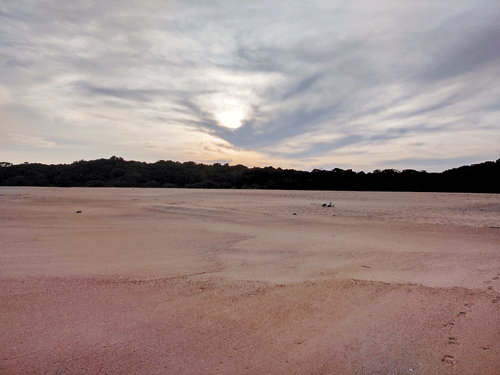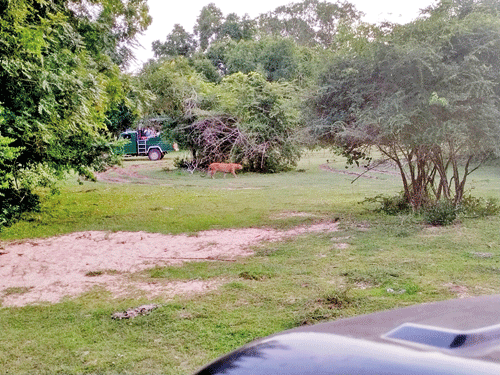Relishing the sights, sounds of a dry zone wildlife paradise

Sunset at Kumana: Wide, wild vistas. Pix by Pamal Yapa
The litany of names says it all: Bagura, Maha Lenama, Selawa, Itikala, Andarakala …The Kumana National Park is the quintessential dry zone wildlife paradise – villus, grassland, lake, gal kem or rock pools, desolate white beaches and ancient relics of a Ruhuna country civilization. Here touched by cerulean, ochre and dry green, undulate daily a saga of life, death and the survival of the fittest against rock caves with prehistoric Veddah art and ruined monasteries.
We drove up in the afternoon to the serene lake by the park gate reflecting the sky with some cormorants in their classic posture with gleaming wings spread wide to dry.
One feels the whiff of a heady adventure about to begin after jumping into the hefty, high-backed turtle of a Toyota which trundles with a roar past the park gate and the lake.
At first you drive through scrub jungle but soon you get to see vistas wide, wild and free. Here is land of briny air that had known man and god; beast and primeval ‘hominid’. Not far away, within the Wildlife Department perimeter, is the Kebilitte jungle shrine where Kataragama is propitiated by pilgrims travelling weary miles. Also famed are the extinct man-eating hairy dwarfs of legend – the ‘Nittaewo’.
Spotted deer abound in open parkland showing off magnificent antlers. More majestic and aloof are the sambhur with their air of monarchs of the glen (or rather the ‘glade’).
Leopards, of course, are treated as royalty. Any sighting and the news crackles through cellphones, drawing cars to stand bumper to bumper, long distance cameras protruding like crab eyes from the vehicles.
We were graced by two big felines; one with his hackles raised trying in vain to stalk a sambhur (unfortunately too far away to photograph) and one slipping between cars like a diva deigning to give fans a glimpse, while walking from his evening perch of a rock to the cover of the jungle.
The sight of a wild leopard is truly intoxicating – the thrilling feeling of having been on the same plane as the secretive beautiful creature.
Elephants are often seen on the dusty track. They can be such pranksters, playing a well-rehearsed game with the jeeps – a mock charge and a trumpeting if you get too close.
After passing through the famous Yoda Lipa (the ‘giant hearth’ formed by three huge stones) we saw a jackal, always a welcome sight. These creatures full of character with the golden sun on their backs have a canny intelligent appeal.
A crocodile obliged us with its prehistoric jaws half open by Kumana wewa, basking in the golden dusk glow.
The bear was a black blur in the scrub fumbling amidst shadows like the Mahasona of the village legends.

Highlight: The thrill of spotting a leopard
Scattered in the park are ancient shrines such as Bowattegala and Bambaragastalawa – names that conjure up jungle tide places where in ancient times a classical civilization flourished with monks and learning. Just like the former Kumana village (remnants of which you see near the Itikala and Yakala lagoons) which was swallowed by the park in the 1980s, the early civilization dwindled long ago.
We crowned the drive with a stop at the beach. The white sands of the sea of Panampattu enticed us. Not far away is the Okanda shrine, where god Kataragama landed in his golden boat, and here, the dunes just spread and spread by the twilight sea.
Curiously, the avians that give Kumana its fame – the normally buzzing shroud of birds animating lagoon and wewa and canopy– had mostly marked themselves absent.
As we left, the sky had darkened. A nightjar rose whirring ghostly off the ground and whisked itself off to the dark shadows beginning to thicken. It was time for another realm – for another order to assert itself over the world of Yala East; and we would, no longer, be welcome here.
Searching for an ideal partner? Find your soul mate on Hitad.lk, Sri Lanka's favourite marriage proposals page. With Hitad.lk matrimonial advertisements you have access to thousands of ads from potential suitors who are looking for someone just like you.


